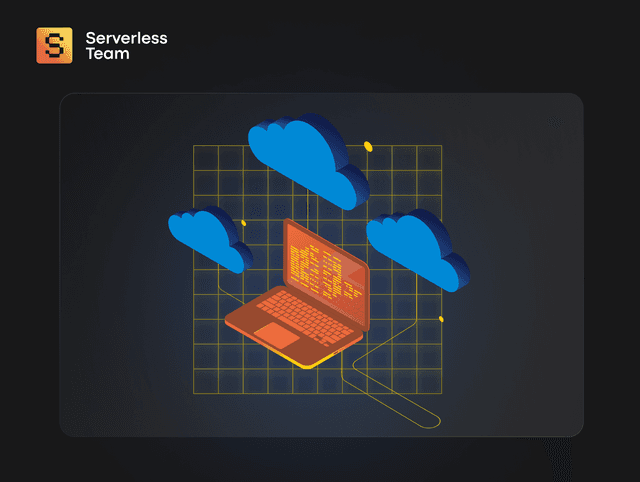What to choose for a project Serverless or Docker containers? This article gives you a detailed serverless and Docker containers comparison, providing valuable insights to help you make informed decisions for your projects.
The way apps are built today is different from a decade ago. Heck, it differs from a year ago even. Today's dynamic tech landscape makes cloud-based deployment options of the utmost significance, providing businesses with enhanced flexibility and scalability. Two notable choices, serverless architecture and Docker containers, stand out for their unique features. Serverless architecture vs. containers—which is yours ‘the one’?
Leveraging our expertise in serverless development, we're pioneers in crafting cloud solutions that cut infrastructure costs while swiftly deploying applications. Our clients benefit from 3.5 times increased client capacity and a 37% cut in cloud costs. Join us as we explore Docker vs. Serverless to determine the optimal fit for your specific needs.

We take care of serverless development so you can focus on your business
Don't want to wait for our site launch? Let's talk about your idea right now.


Serverless vs. Containers: A Detailed Comparison</strong>
Choosing the right deployment option for your app can (and will) significantly impact its performance, scalability, and maintenance requirements. In this section, we'll delve into the strengths and weaknesses of two popular cloud-based deployment models: serverless architecture and Docker containers. Understanding their respective pros and cons will help you make an informed decision for your specific use case.
Serverless Architecture
Serverless architecture is a cloud computing model that allows developers to focus solely on writing code without the need to manage the underlying infrastructure. In this model, the cloud provider takes care of server provisioning, scaling, maintenance, and resource allocation, enabling developers to deploy and run code in response to events or triggers.
| Pros | Cons |
|---|---|
| Cost Efficiency | Vendor Lock-in |
| Serverless platforms follow a pay-as-you-go pricing model, allowing you to optimize costs by paying only for the actual compute time and resources consumed | Adopting serverless platforms may lead to vendor lock-in, making it challenging to migrate to another provider without significant modifications. |
| Scalability: Serverless architecture automatically scales the application based on demand, ensuring seamless performance during traffic spikes without manual intervention. | Limited Control: Serverless platforms abstract infrastructure details, which can be advantageous for ease of use but limits low-level control over the underlying environment. |
| Ease of Deployment | Cold Start Latency |
| Developers can focus solely on writing code without worrying about server provisioning and management, streamlining the development process. | Serverless functions, known as cold start latency, experience a slight delay during initialization, which can impact real-time responsiveness for certain applications. |
| Maintenance Simplification | |
| With the serverless model, the cloud provider handles server maintenance, security updates, and scaling, reducing the maintenance burden for the development team. |
Now, let’s take a look at docker containers.
Docker Containers
Docker container deployment involves utilizing Docker, a containerization platform, to package applications and their dependencies into isolated containers. Containers are lightweight, portable, and consistent environments that encapsulate everything an application needs to run, including the code, runtime, libraries, and system tools.
| Pros | Cons |
|---|---|
| Portability | Resource Overhead |
| Docker containers encapsulate applications and their dependencies, ensuring consistent behavior across different environments and facilitating seamless deployment across diverse platforms. | Running multiple containers on a single host may require more resources compared to serverless functions that are dynamically managed. |
| Flexibility | Complex Orchestration |
| Docker enables microservices architecture, allowing you to break down applications into smaller, manageable components that can be deployed and updated independently. | Managing containerized applications across a cluster of hosts requires orchestration tools like Kubernetes, adding complexity to the infrastructure setup. |
| Isolation | Persistent Storage |
| Containers provide strong isolation between applications, enhancing security and reducing the risk of dependencies interfering with each other. | While containerized applications are ephemeral, handling persistent data storage and backups may involve additional configuration and management. |
| Easy Scaling | |
| Docker containers can be quickly scaled horizontally, accommodating varying workloads and optimizing resource utilization. |
When we compare Serverless architecture and Docker containers, both of these models offer unique advantages and challenges. Evaluating your project's specific requirements and considering factors like cost, scalability, control, and maintenance will guide you in making the best decision for your application.
Each approach has its strengths, and choosing the right one depends on the context and objectives of your project. Get in touch to figure out what suits your project best.
Differences in Scalability
When choosing between Serverless or Docker containers, scalability is a critical aspect of modern application deployment, whether it’s serverless or containers; both of these models offer unique approaches to handle it effectively.
Serverless Architecture
Serverless platforms offer effortless scalability, automatically adjusting to handle increased requests without manual intervention. Developers are relieved from infrastructure management and scaling configuration, allowing a focus solely on application logic.
Nonetheless, it's crucial to consider limitations on concurrent executions and execution duration, especially for applications demanding continuous high scalability or extended execution times.
Docker Containers
Docker's lightweight containers enable efficient scaling by sharing the host OS kernel, which is ideal for applications with fluctuating workloads. However, orchestration and scaling in Docker demand a deeper understanding of infrastructure management and proactive monitoring to prevent performance issues.
While serverless platforms offer automatic scaling based on event triggers, Docker containers require manual orchestration for horizontal scaling, with the choice between them depending on project goals and requirements.
Cost Considerations
The price difference between Docker containers and Serverless plays a significant role in determining the most suitable deployment option between serverless computing vs. containers for a project. Both approaches have different cost implications, and understanding these financial aspects is crucial for making an informed decision.
Serverless Architecture
Serverless architecture offers cost efficiency through a pay-as-you-go model, billing only for function execution time and resources used, ideal for sporadic workloads. Additionally, serverless platforms manage infrastructure, scaling, and maintenance, reducing operational overhead.
They also eliminate the need for dedicated DevOps teams. However, continuous high traffic and long execution times may lead to higher costs due to charges for each function execution and resource utilization.
Docker Containers
Docker containers offer cost advantages with a different cost structure. They utilize resources efficiently by sharing the host OS kernel and providing flexibility in infrastructure choice. However, costs are primarily associated with provisioning and maintenance, and manual scaling may lead to overprovisioning, particularly for applications with varying workloads.
Additionally, managing containerized applications may require a dedicated DevOps team or expertise in orchestration tools like Kubernetes, adding to operational costs. Hence, both serverless architecture and Docker containers offer benefits depending on project requirements and workload patterns.
You may want to learn about Serverless Architecture vs. Monolith Architecture too.
Ease of Deployment
When it comes to the ease of deployment, serverless architecture and Docker containers offer distinct approaches, each with its own set of benefits and challenges. Let's compare and contrast the deployment processes for both:
Serverless Architecture
Serverless architecture streamlines deployment by allowing developers to focus on writing code while the platform handles infrastructure setup and management. Applications are deployed by packaging code into function units, automatically scaled and load-balanced by the serverless platform.
This approach reduces deployment time and effort, enabling seamless updates and continuous deployment without interrupting the application.
However, the simplicity of serverless deployment can lead to limited control over the underlying infrastructure, which may be a drawback for projects with specific performance or serverless security requirements.
Docker Containers
Deploying applications with Docker involves upfront configuration, encapsulating code, runtime, libraries, and dependencies for consistency. Docker images are blueprints for containers that are easily deployable across environments for consistent deployment.
Containers offer flexibility across local machines, virtual machines, or cloud instances, while orchestration tools like Kubernetes automate scaling and management. However, setup complexity may require dedicated DevOps expertise.
Maintenance Overhead
Once your application is up and running, a critical factor to consider is the maintenance overhead. This refers to the ongoing efforts required to manage, update, and sustain your system over time. Let’s explore the maintenance overhead associated with both serverless and Docker containers deployment models.
Serverless Architecture
Serverless architecture minimizes maintenance overhead by shifting operational tasks to the cloud service provider. This frees developers to focus on code development and application logic while the provider handles server provisioning, scaling, and monitoring.
You may be interested in reading about the best Serverless monitoring tools.
The stateless and ephemeral nature of serverless functions eliminates the need to manage long-lived server instances or updates, as the cloud provider ensures platform security and updates, freeing you from infrastructure maintenance.
Docker Containers
Docker containers offer greater control over infrastructure but require increased maintenance, including updating images and containers with patches and security updates. Managing dependencies and compatibility across environments can be time-consuming, with potential issues between containers and host systems requiring debugging.
Additionally, overseeing the maintenance of underlying resources such as virtual machines or cloud instances is necessary, involving server updates, patches, and security configurations.
Considering Performance
We have finally reached the section that is at the front and center of the deployment model consideration — performance. Critical considerations are how fast and efficient your application executes, how responsive it is, and how well it utilizes resources. In this section, we'll delve into the performance characteristics of both serverless and Docker containers deployment models.
Serverless Architecture
Serverless architecture excels in handling sporadic or unpredictable workloads by auto-scaling resources based on demand. It ensures optimal performance during peak times and minimizes resource waste during low-traffic periods. Despite typically fast execution speeds and low response times, concerns about cold start times exist, though most cloud providers mitigate these to maintain consistent performance.
Yet, serverless performance may suffer with long-running tasks or highly compute-intensive workloads, potentially encountering timeouts or limitations imposed by the cloud provider.
Docker Containers
Docker containers offer consistent and predictable performance by running on dedicated hosts. It eliminates cold start delays and provides faster, more reliable response times than serverless. With bundled dependencies, containers ensure better performance isolation. It allows for greater control over allocated resources and fine-tuning for optimal performance.
However, mismanagement may lead to resource overutilization, potentially causing performance bottlenecks and impacting application responsiveness.

Kyrylo Kozak
CEO, Co-founderGet your project estimation!

Best Use Cases for Serverless and Docker Containers
Serverless and Docker containers have distinctive strengths. That’s why it’s necessary to explore their specific use cases before choosing the architecture for your project.
Serverless architecture works best in the following scenarios:
- Event-Driven Workloads: Serverless excels in environments where functions are triggered by certain events like HTTP requests, user actions, or file uploads.
- Microservices: Serverless is well-suited for microservice apps, which require independent deployment and scaling of services.
- APIs and Backend Services: Serverless is a perfect fit for building APIs and backend services, as it allows developers to write code without managing the infrastructure.
On the other hand, Docker containers may suit the following:
- Resource-Intensive Workloads: Docker is ideal for processes that require precise control over resources, apps with specific resource requirements, and systems that need consistent performance across various environments.
- Legacy App Modernization: Docker helps modernize outdated apps by containerizing existing applications.
- Multi-Service Apps: Docker works best in systems comprising multiple services that need communication.
Decision Factors for Your Project
When choosing between serverless architecture and Docker containers for your project, several critical factors should be considered to ensure the deployment option aligns best with your requirements and goals.
Understanding Project Requirements
Begin by thoroughly understanding your project's specific needs, workload patterns, and traffic variability. For apps with unpredictable and sporadic traffic, serverless architecture's auto-scaling capabilities present an advantage. In contrast, containerized apps may be more suitable for steady workloads where resource allocation and fine-tuning are essential.
Scalability Considerations
Consider the scalability requirements of your application. Serverless architecture excels in handling sudden spikes in traffic, as it automatically scales resources based on demand. This flexibility can be a decisive factor for applications with unpredictable or highly fluctuating workloads. On the other hand, if your application has predictable, consistent traffic patterns, container orchestration platforms like Kubernetes can efficiently manage the scalability of Docker containers.
Budget and Cost Considerations
Evaluate your project's budget and cost considerations. As mentioned, serverless architectures follow a pay-as-you-go model, billing only for the resources used during function execution. This can be cost-effective for applications with intermittent usage, as you avoid paying for idle resources. In contrast, Docker containers may require more predictable resource allocation, which could impact cost efficiency if not properly managed.
Can You Use Containers and Serverless Together?
Combining serverless and Docker containers allows you to leverage the strengths of both solutions. So, the answer is a resounding “yes,” and here’s how integrating these technologies may be beneficial:
- Task-Specific Functions: You can use serverless even for monolithic architecture apps, which are too large to migrate to serverless. Identify and extract specific processes like small backend tasks and execute them as serverless functions.
- Event-Driven Architectures: Leverage Docker containers for hosting complex applications and serverless functions to respond to specific events within the app. That’s how you reach a scalable and responsive setup.
- Expanding Serverless with Containers: Serverless functions commonly store data in cloud services, but you can connect these services as Kubernetes persistent volumes. This way, you can seamlessly share data between serverless and containers.
Conclusion
So Docker vs. Serverless - which one will you use? Choosing the right deployment option, whether serverless architecture or Docker containers, is crucial for the success of your project. Both approaches offer distinct advantages and cater to different application scenarios.
If your project requires rapid scalability, cost efficiency for sporadic workloads, and the convenience of not managing infrastructure, serverless architecture may be the ideal choice. On the other hand, if you need more performance predictability, fine-grained control over resources, and steady workloads, Docker containers with container orchestration platforms may better suit your needs.
To make an informed decision, conducting a thorough analysis of your project requirements, scalability considerations, and budget constraints is essential. We know from experience that a simple call can provide you with insights and offer some guidance in choosing the best deployment model for your specific use case.
For a more in-depth analysis and tailored recommendations for your project, we encourage you to contact our expert team for Serverless consulting services.
Our experienced professionals can help you navigate the complexities of cloud deployment models and ensure a seamless and successful implementation for your project. Feel free to schedule a call to explore the best-fit solution for your cloud deployment, serverless migration or cloud infrastructure migration needs.





